“ELF EAR BARRENS”
Adams County Ohio
Last year I received an invitation to participate in a bio-blitz” at a an 87-acra property in Peebles, Adams Coun ty Ohio that was in the process of being acquired by a terrific land trust conservation organization, Arc of Appalachia (AoA). The part of the property that garnered the attention of AoA is the thin soil, low nuturent sunny southeast-facing hillside hoarboring a plant community called a “barrens” that is a unique plant community type for which Adams County is known. However this barrens became that way not through natural geologic and hydrologic conditions, but is what is termed a “secondary barrens,” i.e., one that became that way from repeated logging and. perhaps, grazing. The land is depleted, but the result is rather appealing, with mosses and lichens predominating. Below see how the tract is described in the Arc’s most recent annual report.
ELF EAR BARRENSHere’s what the area looks like on Google Maps.
This is the lichen that the site is named for: the “elf ear” lichen, Normandina pulchella. It has a “squamulose” growth form, intermediate between crustose and foliose.
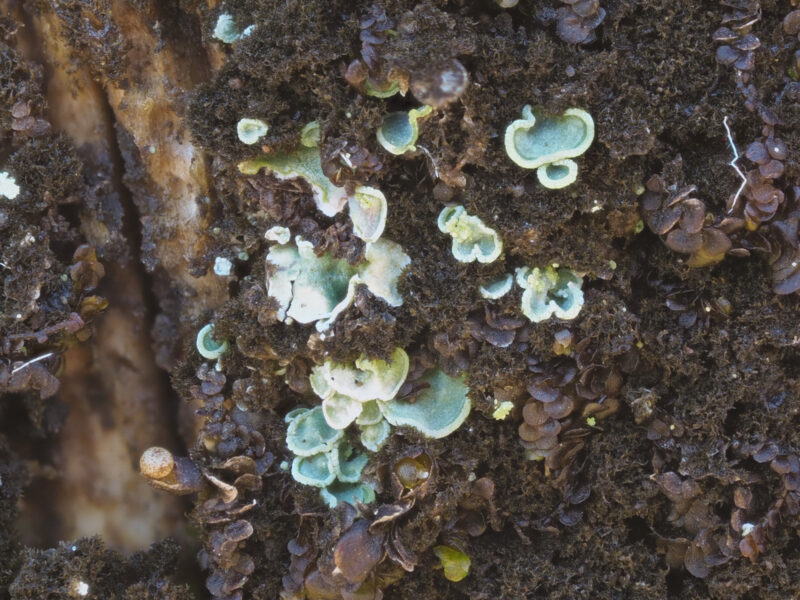
elf-ear lichen
Between Peterson Road and the barren the site is a wooded area with an overstory of Chinquapin oak (Quercus muehlenbergii), sugar maple (Acer saccarum), green ash (Fraxinus pennsylvanica) and blacklocust (Robinia pseudoacacia). The first two are native tree species, while blacklocust, native to North America, was introduced to Ohio (Ohio Department of Natural Resources). Chinquapin oak, as well as several of the other trees and understory species, are pronounced calciphiles, as indicated in Jane Forsyth’s “Geobotany” article (1971). The overall floritic quality assesment index (FQAI) score for this community is 19.29.
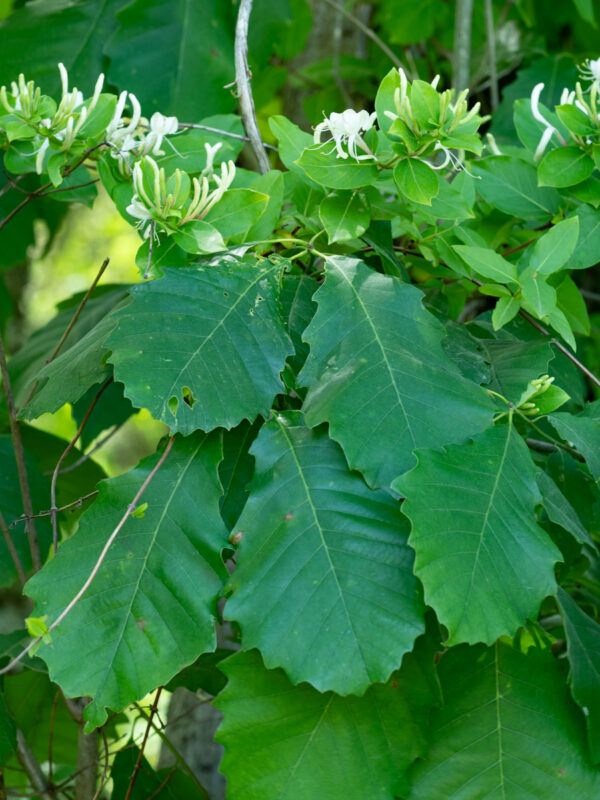
Chinquapin oak is a lime-loving tree.
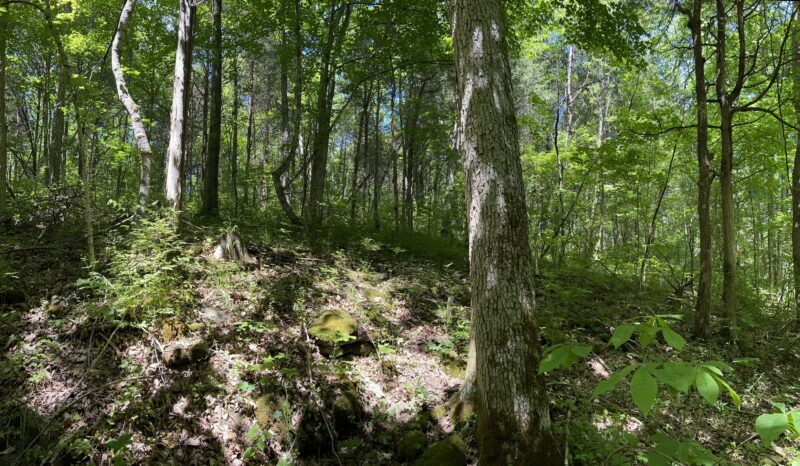
The open woodlands adjacent to Elf Ear Barrens.
The following is a list of species in the wooded portion of the site between Peterson Road and The barrens.
| Polystichum acrostichoides | 3 | CHRISTMAS FERN | Dryopteridaceae | fern |
| Arisaema triphyllum subsp. triphyllum | 3 | JACK-IN-THE-PULPIT | Araceae | forb |
| Cryptotaenia canadensis | 3 | HONEWORT | Apiaceae | forb |
| Cynoglossum virginianum var. virginianum | 5 | SOUTHERN WILD COMFREY | Boraginaceae | forb |
| Galium circaezans | 4 | WILD LICORICE | Rubiaceae | forb |
| Geum vernum | 2 | SPRING AVENS | Rosaceae | forb |
| Krigia biflora | 5 | ORANGE DWARF-DANDELION | Asteraceae | forb |
| Osmorhiza longistylis | 4 | SMOOTH SWEET CICELY | Apiaceae | forb |
| Podophyllum peltatum | 4 | MAYAPPLE | Berberidaceae | forb |
| Sanguinaria canadensis | 5 | BLOODROOT | Papaveraceae | forb |
| Sanicula gregaria | 3 | CLUSTERED SNAKEROOT | Apiaceae | forb |
| Senecio aureus | 4 | GOLDEN RAGWORT | Asteraceae | forb |
| Valerianella chenopodifolia | 4 | GOOSEFOOT CORN-SALAD | Valerianaceae | forb |
| Verbesina alternifolia | 5 | WINGSTEM | Asteraceae | forb |
| Berberis thunbergii | 0 | JAPANESE BARBERRY | Berberidaceae | shrub |
| Lonicera maackii | 0 | AMUR HONEYSUCKLE | Caprifoliaceae | shrub |
| Rhus aromatica var. aromatica | 3 | FRAGRANT SUMAC | Anacardiaceae | shrub |
| Rosa multiflora | 0 | MULTIFLORA ROSE | Rosaceae | shrub |
| Viburnum prunifolium | 4 | BLACK-HAW | Caprifoliaceae | shrub |
| Acer saccharum | 5 | SUGAR MAPLE | Aceraceae | tree |
| Carpinus caroliniana | 5 | BLUE-BEECH | Betulaceae | tree |
| Carya cordiformis | 5 | BITTERNUT HICKORY | Juglandaceae | tree |
| Celtis occidentalis | 4 | HACKBERRY | Ulmaceae | tree |
| Fraxinus pennsylvanica | 3 | GREEN ASH | Oleaceae | tree |
| Quercus muehlenbergii | 7 | CHINQUAPIN OAK | Fagaceae | tree |
| Quercus rubra | 6 | RED OAK | Fagaceae | tree |
| Robinia pseudoacacia | 0 | BLACK LOCUST | Fabaceae | tree |
| Lonicera japonica | 0 | JAPANESE HONEYSUCKLE | Caprifoliaceae | 7 vine |
| Menispermum canadense | 5 | CANADA MOONSEED | Menispermaceae | 7 vine |
| Parthenocissus quinquefolia | 2 | VIRGINIA CREEPER | Vitaceae | 7 vine |
| Smilax hispida | 3 | BRISTLY GREENBRIER | Smilacaceae | 7 vine |
| Vitis riparia | 3 | RIVERBANK GRAPE | Vitaceae | 7 vine |
The barren is sparsely occupied by shrubs and small trees, with eastern redcedar (Juniperus virginiana) predominating. The overall floritic quality assesment index (FQAI) score for this community is 19.43.
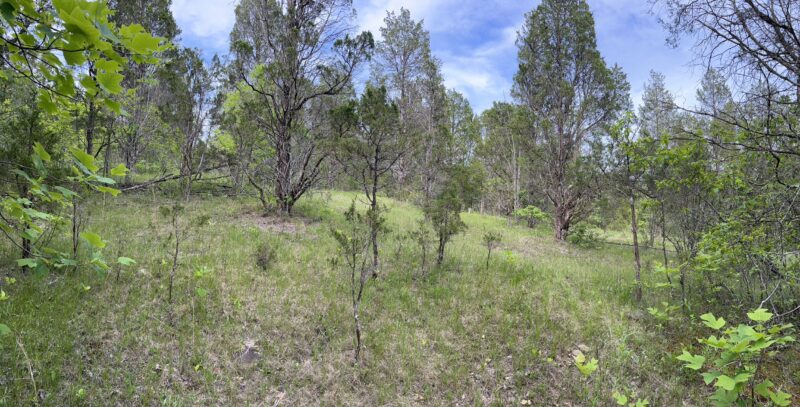
The barrens is a dry south facing hillside with thin soil.
The barrens is home to some interesting species with a fidelity to species with low levels of anthropogenic disturbance, i.e. having fairly high coefficients of conservatism. One of these is hoary puccoon (Lithospermum canescens, a member of the borage family, Boraginaceae) (CC=6). It flowers earlier than most prairie and glade species. According to thye “Illinois Wildflowers” web site the common namne “puccoon” indicayes that the plant was used as a dye plant, and cites its use by Native Americans for pottery, basketry, and “personal ornament.”
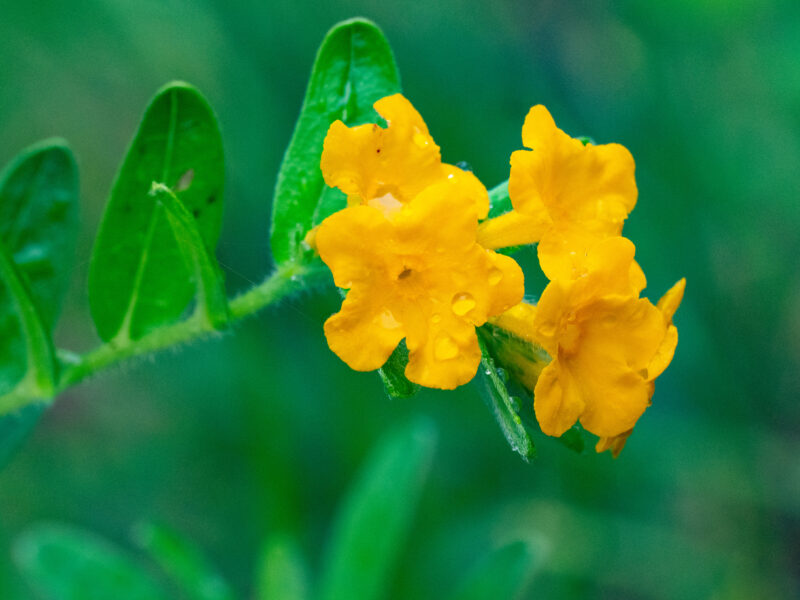
Hoary puccoon is an early-blooming glade and prairie species.
Yellow star grass (Hypoxis hirsuta, in the Hypoxidaceae) (CC=6) is a yellow-flowered showy monocot that could only be mistaken fior a grass when the flowers are absent.
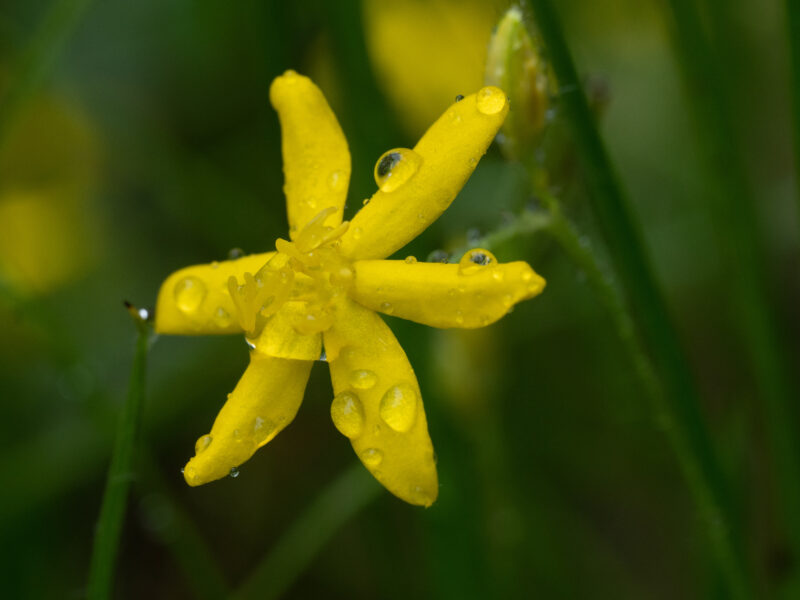
Yellow srar-grass is a showy monocot.
An interesting sedge that breaks the “sedges have edges” rule is this flatstem spikerush (Eleocharis compressa) (CC=7). The genus is recognizable by the single spikelet perched on top if the culm, and the species is distinguished by the flatness of the culms. It is a calciphile found in sunny wet places.
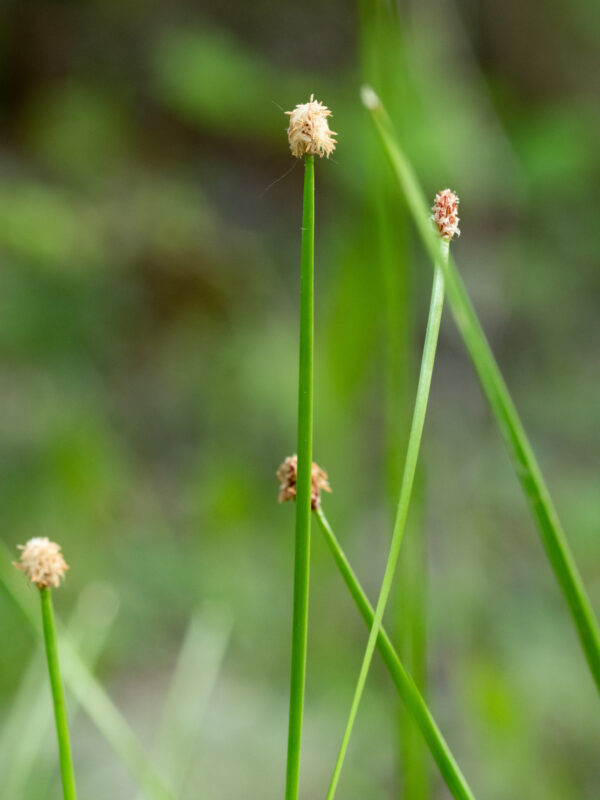
Flatstemmed spikerush is a flat-stemmed spikerush.
The following is a list of species seen at the barrens.
| Onoclea sensibilis | 2 | SENSITIVE FERN | Dryopteridaceae | fern |
| Asclepias viridis | 7 | SPIDER MILKWEED | Asclepiadaceae | forb |
| Calystegia spithamaea | 4 | UPRIGHT BINDWEED | Convolvulaceae | forb |
| Fragaria virginiana | 1 | WILD STRAWBERRY | Rosaceae | forb |
| Hedyotis canadensis | 6 | CANADA BLUETS | Rubiaceae | forb |
| Hypoxis hirsuta | 6 | YELLOW STAR-GRASS | Liliaceae | forb |
| Lespedeza cuneata | 0 | CHINESE BUSH-CLOVER | Fabaceae | forb |
| Lithospermum canescens | 6 | HOARY PUCCOON | Boraginaceae | forb |
| Lobelia spicata | 5 | PALE-SPIKE LOBELIA | Campanulaceae | forb |
| Potentilla simplex | 1 | OLD FIELD CINQUEFOIL | Rosaceae | forb |
| Rhus aromatica var. aromatica | 3 | FRAGRANT SUMAC | Anacardiaceae | shrub |
| Eleocharis compressa | 7 | FLAT-STEM SPIKE-RUSH | Cyperaceae | sedge |
| Cornus florida | 5 | FLOWERING DOGWOOD | Cornaceae | sm tree |
| Diospyros virginiana | 4 | PERSIMMON | Ebenaceae | sm tree |
| Juniperus virginiana | 3 | EASTERN RED CEDAR | Cupressaceae | tree |
| Liriodendron tulipifera | 6 | TULIP TREE | Magnoliaceae | tree |
| Pinus virginiana | 3 | VIRGINIA PINE | Pinaceae | tree |
| Quercus imbricaria | 5 | SHINGLE OAK | Fagaceae | tree |
| Quercus marilandica | 8 | BLACKJACK OAK | Fagaceae | tree |
| Quercus stellata | 7 | POST OAK | Fagaceae | tree |
The site is home to several striking mosses. Broom moss (Dicranum scoparium) is an especially large cushion moss found in the ground along with fruticose cladonia lichens. At this tile of the year there are abundant sporophytes in the “spear stage.”
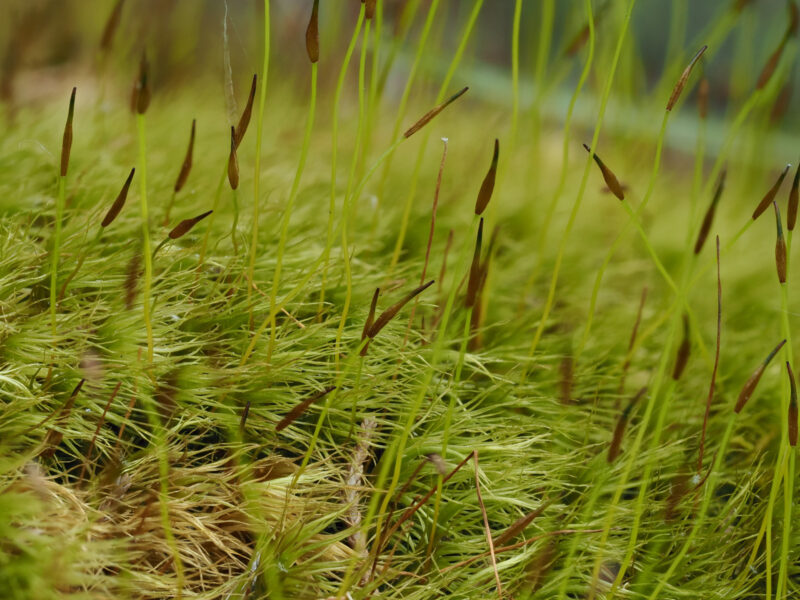
Broom moss is a large acrocarp with hairlike leaves.
